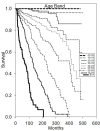Clinicopathologic Features and Survival Trends for Acinic Cell Carcinoma of the Major Salivary Glands: A Surveillance, Epidemiology, and End Results Population Analysis
- PMID: 33117462
- PMCID: PMC7575277
- DOI: 10.14740/wjon1312
Clinicopathologic Features and Survival Trends for Acinic Cell Carcinoma of the Major Salivary Glands: A Surveillance, Epidemiology, and End Results Population Analysis
Abstract
Background: We analyzed a population-based national registry to identify the most influential patient pretreatment and treatment factors affecting overall survival (OS) and cause-specific survival (CSS) in patients diagnosed with acinic cell carcinoma (ACC) of the major salivary glands.
Methods: Using the Surveillance, Epidemiology, and End Results (SEER) database of the US National Cancer Institute (NCI) related to survival, a total of 1,254 patients with diagnosed ACC of the major salivary glands from 1975 to 2016 met inclusion criteria. Factors significant for OS and CSS were determined using univariate and multivariate analysis with the Cox proportional hazards model.
Results: Univariate OS analysis demonstrated that surgery favorably influenced longer survival compared to no surgery (hazard ratio (HR) 2.35, P < 0.05). Patient age was found to be highly predictive of superior OS (divided into 10-year age bands, P < 0.0001, younger age better). In multivariate OS analysis, there were statistically significant worse outcomes for men (HR 1.54, P < 0.05), grades III/IV (HR 2.5, P < 0.05), and distant disease (HR 3.55, P < 0.05) or regional disease (HR 1.22, P < 0.05). Patients diagnosed during years 1996 - 2016 had better OS when compared to earlier decades 1975 - 1995 (HR 1.38, P < 0.05). In univariate analysis, the mean CSS for grades I, II, and III/IV were 429 months (95% confidence interval (CI), ± 38.39), 426 months (95% CI, ± 25.73) and 198 months (95% CI, ± 66.38). Multivariate analysis of CSS further demonstrated that there were statistically significant worse outcomes for men (HR 1.68, P < 0.05), grade III/IV (HR 3.2, P < 0.05), tumor size greater than 40 mm (P < 0.001), and distant disease (HR 4.48, P < 0.05) or regional disease (HR 1.84, P < 0.05).
Conclusions: To our knowledge, this is the largest population-based study of OS and CSS of major salivary gland ACC. We found that the patient pretreatment and treatment factors including younger age at diagnosis, female sex, early stage, lower grade, surgical excision, and recent year of diagnosis are associated with improved survival in patients diagnosed with ACC of the major salivary glands. We hope that this information will aid in construction of further research projects that better refine optimal treatment protocol of individualized patient care.
Keywords: Cancer; Head and neck; Radiation; Salivary gland; Surgery.
Copyright 2020, Kaya et al.
Conflict of interest statement
None to declare.
Figures
Similar articles
-
Overall and cause-specific survival for mucoepidermoid carcinoma of the major salivary glands: Analysis of 2210 patients.World J Clin Oncol. 2020 Dec 24;11(12):1029-1044. doi: 10.5306/wjco.v11.i12.1029. World J Clin Oncol. 2020. PMID: 33437665 Free PMC article.
-
Radiotherapy and Male Breast Cancer: A Population-based Registry Analysis.Am J Clin Oncol. 2016 Oct;39(5):458-62. doi: 10.1097/COC.0000000000000078. Am J Clin Oncol. 2016. PMID: 24781343
-
A Clinical Model of Bone Angiosarcoma Patients: A Population-based Analysis of Epidemiology, Prognosis, and Treatment.Orthop Surg. 2020 Dec;12(6):1652-1662. doi: 10.1111/os.12803. Epub 2020 Sep 10. Orthop Surg. 2020. PMID: 32914587 Free PMC article.
-
The prognostic value of selective neck dissection in early-stage major salivary gland carcinoma: a population-based analysis.Front Oncol. 2024 May 22;14:1347339. doi: 10.3389/fonc.2024.1347339. eCollection 2024. Front Oncol. 2024. PMID: 38841169 Free PMC article.
-
Sinonasal Acinic Cell Carcinoma: A Review of the National Cancer Database.Am J Rhinol Allergy. 2022 Nov;36(6):741-746. doi: 10.1177/19458924221107206. Epub 2022 Jun 14. Am J Rhinol Allergy. 2022. PMID: 35702005 Review.
Cited by
-
Prognostic factors for sublingual gland carcinoma: a population-based Surveillance, Epidemiology and End Results database study.J Int Med Res. 2023 Nov;51(11):3000605231187940. doi: 10.1177/03000605231187940. J Int Med Res. 2023. PMID: 37944187 Free PMC article.
-
Acinic Cell Carcinoma in the 21st Century: A Population-Based Study from the SEER Database and Review of Recent Molecular Genetic Advances.Cancers (Basel). 2023 Jun 27;15(13):3373. doi: 10.3390/cancers15133373. Cancers (Basel). 2023. PMID: 37444484 Free PMC article.
References
-
- Krane JF, Faquin WC. Cytology: diagnostic principles and clinical correlated third edition. Elsevier Inc; Salivary gland: 2009. - DOI
LinkOut - more resources
Full Text Sources
Miscellaneous



